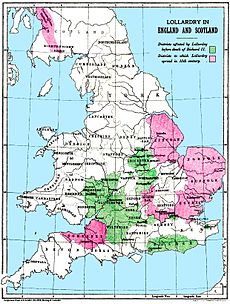Oldcastle Revolt facts for kids
Quick facts for kids Oldcastle Revolt |
|||||||
|---|---|---|---|---|---|---|---|
|
|||||||
| Belligerents | |||||||
| Lollards | |||||||
| Commanders and leaders | |||||||
| Sir John Oldcastle Walter Blake Sir Roger Acton |
|||||||
| Strength | |||||||
| 222 | |||||||
| Casualties and losses | |||||||
| 80 (POW) +79 |
|||||||
The Oldcastle Revolt was a rebellion by a group called the Lollards. They were unhappy with the Catholic Church and the English king, Henry V. This uprising was led by Sir John Oldcastle. It happened on the night of January 9th to 10th, 1414. The king's forces quickly stopped the rebellion at St. Giles's Fields.
Contents
Who Was John Oldcastle?
John Oldcastle was born around 1370. He inherited family lands in places like Almeley and Hereford in 1397. Oldcastle became a knight in 1400. He served the king in battles against Scotland and during the Glyndŵr Rising in Wales.
His loyalty helped him gain more land and money. In 1408, he married Baroness Joan Cobham. This marriage brought him even more estates across England.
Oldcastle's Religious Beliefs
Oldcastle's ideas about religion were shaped by a Lollard preacher named William Swynderby. Lollardy was a religious movement started by John Wycliffe in the 1370s. Lollards had different beliefs from the main Catholic Church.
For example, they were against the death penalty. They also believed priests should be allowed to marry. Lollards thought that church leaders should be judged by regular courts. They also did not like Christian pilgrimages or Christian art in churches. They felt these things took away from focusing on God.
Oldcastle became more and more radical in his beliefs. He even wrote to Hussite leaders, who were similar religious reformers. He supported their opposition to the main clergy. He also helped create new laws against the power of the church in 1410.
Friendship with King Henry V
In 1411, Oldcastle fought alongside Henry, Prince of Wales. They were part of an English army helping Burgundy in a civil war. Their friendship grew stronger during this time.
However, the spread of Lollardy worried Archbishop Thomas Arundel. Arundel tried to accuse Oldcastle of spreading ideas against the church. King Henry V was hesitant to let the church punish his close friend. But by August 1413, the king grew tired of Oldcastle's disobedience. He finally allowed Arundel to take action.
Oldcastle's Arrest and Escape
Arundel ordered Oldcastle to appear at Leeds Castle in September 1413. Oldcastle ignored the order and went to his own castle, Cooling Castle. Arundel then declared Oldcastle excommunicated, meaning he was no longer part of the church.
Oldcastle was arrested and taken to the Tower of London. There, he openly criticized the Pope. He also rejected the worship of the cross and the practice of confession. Because of these statements, Oldcastle was charged as a heretic and sentenced to death.
King Henry V stepped in one more time. He gave Oldcastle 40 days to change his mind. But Oldcastle used this chance to escape on October 19th. He was helped by a group of London Lollards. He then hid at a Lollard's house in Smithfield.
The Revolt Begins
In November 1413, Oldcastle started sending messages to Lollard followers across England. Wealthy Lollards helped by raising money. They used it to buy equipment and hire fighters for the rebellion.
The rebels were told to meet at St. Giles' Fields on January 9th, 1414. Lollards from different parts of England began to gather. For example, a group from Bristol and Somerset traveled to London. This group included at least 30 people, led by a chaplain named Walter Blake.
Other groups came from places like Daventry, Leicester, and Buckinghamshire. In total, about 222 rebels gathered. This included three knights and 15 esquires (young noblemen).
The King's Response
The king had spies, John Barton and Thomas Burton. They found out about Oldcastle's hiding place. On January 7th, King Henry V issued a warning. He banned any illegal gatherings. People suspected of planning the revolt were arrested.
Oldcastle realized his plans were known. But his supporters were already at St. Giles' Fields. So, he decided to go ahead with his goals. He wanted to destroy Catholic churches and overthrow the king.
On the night of January 9th to 10th, 1414, King Henry gathered his troops. They were at St. John's Priory in Clerkenwell. He also sent patrols to stop more rebels from joining the main group.
The king's army attacked the rebels. Oldcastle and some Lollards fled immediately. Other rebels tried to fight back but were defeated by the larger royal army.
Aftermath of the Revolt
On January 10th, trials began for the 80 Lollards captured after the battle. They were charged with treason and heresy. Most of them were put to death. The king also sent officials to areas with many Lollards. They arrested local Lollards and rebels, even if they had not taken part in the revolt.
More arrests followed. Rebel leaders Walter Blake and Sir Roger Acton were caught and executed. But Oldcastle managed to escape with help from an old friend. He was finally arrested near Welshpool in Wales. Oldcastle was then taken to London. He was put to death at St. Giles's Fields on December 14th, 1417.
See also
- List of people burned as heretics
- Hussites


